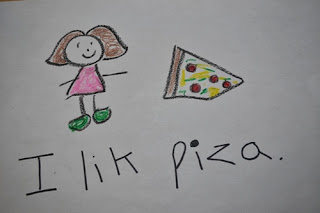Young children can and do write.
They want to show others what they know. Children
move through three states of
scribbling for writing according to Clay (1975). In the first stage
they scribble for pleasure. In
the second stage children acquire the knowledge that written
symbols convey meaning and they
believe adults can read their writing. The third stage includes
mock letters and beginning letter
sounds. The children describe their messages by what they
hope they have written.
Along with writing, children
draw. Drawing is one of the primary ways children
communicate. There are also
stages of drawing. These stages include: scribbling, preschematic,
schematic, gang, pseudo-
naturalistic and the period of decision (Lowenfeld 1987) Kindergarten
students are typically in the preschematic
or schematic stage. The preschematic stage is
characterized by symbols
constantly changing. The schematic stage is characterized by
objects
sitting on a baseline and child’s
active knowledge of the subject. The amount and quality of
detail also progresses from a
minimal stage to increasing attention to more specificity working its
way towards greater elaboration
and patterning (Carroll 2003).
According to Karnowski (1986)
young writers use drawing to explain their writing and
they use it as a prewriting
strategy. Drawing helps children plan and organize the written text.
Often students will draw first in
order to get their thoughts on paper. After the thoughts are
drawn the children can use their
picture to remember their story and write it down. Vygotsky
(1978) stated that children’s
drawings capitalize on the narrative impulse that emerges in their
earliest drawings, on their
tendency to create story drawings and on the talk that surrounds and
supplements the drawing events.
There is a correlation between
children’s drawing levels and writing readiness because
both are grounded in making
shapes, lines and symbolic representation (Carroll 2003). As
writing progresses, so does
children’s reading readiness. Children learn to read and write most
easily when they encounter texts
that they themselves have authored (Sidelnick, Svoboda 2000 p
175) Teachers must capitalize on
this knowledge to help create great readers and writers.
Teachers of these young students
must remember several guidelines when allowing
students to write. Teachers need
to know what their students understand about communication
and writing upon entering school.
With this knowledge teachers can help foster writing in their
class. Teachers need to redefine
their idea of writing. Writing in the early years takes many
forms and all must be valued and
encouraged if a teacher wants to see growth in all their
children. Teachers must also
understand that children use everything they know about
communication in oral language,
art, music and drama to make sense of the writing process. The
children use familiar
communication systems to add depth and meaning to their newly acquired
skill of writing (Karnowski
1986).
Children will make progress with
their drawing and writing if they are provided with
time, materials, information, and
freedom to invent meaningful language (Hayes 1990).
Children need to be immersed in a
literacy focused environment in order to foster their writing
skills.
Children in an environment that
fosters writing should be given different occasions to
write. These opportunities will
provide students with extending their writing knowledge.
Children should at times use a
sketchbook/journal where they can freely write and draw what
they want to. They also should
attempt drawing by diction. It requires another level of
processing skills. A third type
of drawing is drawing by request. A topic is given to the children
and they must write or draw about
it. All of these help children to become great writers.
Great writers use certain
qualities when they write. These qualities have become known
as traits. 6 Trait writing is a “hot
button” topic in schools throughout the world.
What
is 6 Trait Writing?
6 Trait Writing began in 1983
when a school in Oregon wanted to assess student writing as well as teach
writing. They wanted an instrument that would provide accurate, reliable
feedback to students and teachers
that would help guide instruction. In order to understand what
10
good writing was a group of
teachers read hundreds of papers written by students. They agreed
upon six qualities that
demonstrate great writing. The qualities, now known as traits are,
· Ideas (details,
development, focus)
· Organization
(internal structure)
· Voice (tone,
style, purpose, and audience)
· Word choice
(precise language and phrasing)
· Sentence fluency
(correctness, rhythm, and cadence)
· Conventions
(mechanical correctness)
· And another has
now been added. . .presentation (handwriting, formatting, layout)
These traits became the
foundation for the descriptive criteria used to define qualities of
good writing at different levels
of achievement. Rubrics were created to assess the writing done
by students.
Enjoy,
Ms. Nora Sierra








